
Barbara Kruger
I Shop Therefore I Am, 1990
Though advertising — and its obvious association with capitalism — is often considered the antithesis of “real” art, it has today become a crucial part of the art world and of artists’ livelihoods. The interconnection between advertising and fashion is one of the foremost reasons why fashion is not considered art. Yet a closer look into fashion advertisements will reveal the work of complex and famed artists who disrupt the lines drawn between art and advertising, and create partnerships that elevate the fashion world, proving that advertising is an art in itself.
Many brands use famous photographers to shoot their campaigns, allowing the brand’s image and the photographer’s own aesthetic to merge together into a collective work. Helmut Lang, for example, did some very influential work in this realm. The conceptual artist Jenny Holzer began working with Lang in 1996. Their first project together was a projection installation for the 1996 Florence Biennale, titled I Smell You on My Clothes. The installation also contained LED signs made by Holzer, projecting phrases like “YOU ARE THE ONE,” “YOU ARE THE ONE WHO DID THIS TO ME,” and “YOU ARE MY OWN,” and a Helmut Lang experimental fragrance was pumped into the air.
In 1998, Holzer and Helmut Lang were brought together again for the opening of the designer’s flagship store in New York City. Centered was one of Holzer’s LED pieces with repeating phrases. The store itself broke from the conventional retail space: the clothes were hidden in cabinets and the cash registers were hidden, leaving an imposing white space. In 2000, the pair once again worked together to launch the brand’s fragrance, and created a collaborative advertising campaign for Lang’s self titled perfume, using the alluring catch phrase I Smell You on My Skin, as a self-reference to the pair’s first collaboration at the Florence Bienalle in 1996. Rather than traditional perfume advertising, which works to create an immersive fantasy space, Holzer’s stark newspaper-style words across paper, a tiny logo, and lack of product shots was the epitome of anti-advertising. Holzer and Helmut Lang’s collaboration breathed new life into the tired designer-artist pair up. Both rejected the conventional, and together they broke the mold of traditional fashion advertisements.
Helmut Lang and Jenny Holzer
Florence Biennale, I Smell You on My Clothes, 1996
Helmut Lang and Jenny Holzer
Florence Biennale, I Smell You on My Clothes, 1996
Helmut Lang and Jenny Holzer
Store on Greene Street, NYC, 1998
Helmut Lang and Jenny Holzer
Store on Greene Street, NYC, 1998
Helmut Lang and Jenny Holzer
Fragrance Advertisement, 2000
From 1997-98, Helmut Lang worked with the estate of photographer Robert Mapplethorpe on a series of ads featuring still life photographs and Mapplethorpe’s self-portraits; oddly, the advertisements never featured what they were actually advertising: Helmut Lang Jeans, for example. Instead, they projected Mapplethorpe’s blunt and unyielding aesthetic onto the brand; aligning Helmut Lang with the dark, artistic persona associated with the late photographer’s work and career. For the brand’s Autumn/Winter 1997 campaign, Bruce Weber photographed Louise Bourgeois – a female artist known for her provocative sculptures and complex installations. The following season, painter and photographer Richard Prince also worked with Lang, shooting a 1998 ad campaign comprised of out of focus, neutral-toned photographs. Yet again, Helmut Lang was more focused on associating itself with a certain aesthetic through these respective artists’ work, ones that ultimately worked well with the brand’s overall vision.

Helmut Lang, Jeans Ad Campaign
Untitled (Layers of Underwear), Robert Mapplethorpe, 1970

Helmut Lang, Ad Campaign, S/S 1997
Use of Robert Mapplethorpe's Photographs and Artworks

Helmut Lang, Ad Campaign, F/W 1997-98
Louise Bourgeois photographed by Bruce Weber

Helmut Lang, Ad Campaign, F/W 1997-98
Louise Bourgeois photographed by Bruce Weber

Helmut Lang, Ad Campaign, F/W 1999-00
Louise Bourgieous photographed by Robert Mapplethorpe, 1982

Helmut Lang in Purple Magazine
Photography by Richard Prince, 1998-99

Helmut Lang in Purple Magazine
Photography by Richard Prince, 1998-99
Comme des Garcons is yet another fashion house to historically utilize artist collaborations to create unconventional advertisements. Acclaimed photographer Cindy Sherman, for example, went appropriately out of the box in her 1993 advertising campaign for the brand. Using her self-portrait-in-disguise technique, Sherman’s photographs confronted consumers with models that look disappointed and uncomfortable rather than idealized, a fitting campaign for as boundary-pushing a designer as Rei Kawakubo. Abraham Mignon used lyrics by the Pet Shop Boys overlaid atop images of still life paintings for an Autumn/Winter 1989 campaign, while in 1995, Comme des Garcons teamed up with Japanese photographer Keizo Kitajima for a series of photographs in international cities. Much like Helmut Lang’s anti-product ad campaigns, in 2010 the Japanese brand teamed up with contemporary artist Simen Johan who created a long-haired white animal sculpture on a glittery pedestal for a Comme des Garcons SHIRT advertisement. Other artists who Kawakubo has worked with for ads include Daniel Clowes, Magda Archer, Berge Jensen, and Paul Granjon; all of whom created unconventional images that reflect Kawakubo’s messages about the constructed body and the fashion industry.
Cindy Sherman for Comme des Garcons
F/W 1993
Cindy Sherman for Comme des Garcons
F/W 1993
Cindy Sherman for Comme des Garcons
F/W 1993
Cindy Sherman for Comme des Garcons
F/W 1993
Comme des Garcons, Ad Campaign, F/W 1989
Abraham Mignon Painting with Pet Shop Boys Lyrics
Comme des Garcons, Ad Campaign, F/W 1989
Abraham Mignon Painting with Pet Shop Boys Lyrics
Comme des Garcons, Ad Campaign, 1994
Photographed by Keizo Kitajima
Comme des Garcons, Ad Campaign, 1994
Photographed by Keizo Kitajima
Comme des Garcons, Ad Campaign, 1994
Photographed by Keizo Kitajima
Comme des Garcons, Ad Campaign, 1994
Photographed by Keizo Kitajima
Comme des Garcons, Ad Campaign, 2010
Sculpture by Simen Johan
Artistic advertisements are not only seen in campaigns of avant-garde brands, other more traditional fashion houses have taken fittingly traditional approaches to advertising that still exhibit a level of artistic expression, often using photography as the artistic medium. Bottega Veneta worked with photographer Nan Goldin, whose work is known as both intimate and documentarian, for a 2010 Spring/Summer campaign. The soft, sun-lit images highlight the beauty of the clothes. The following season, artist Robert Longo photographed a series of black and white images for the brand’s campaign, in which the models are contorted into odd shapes and sharp angles that mimic Longo’s most celebrated work. For Spring/Summer 2011, photographer Alex Prager shot vivid, surreal images for the brand, while Robert Polidori’s photography, featured in Bottega Veneta’s Fall/Winter 2011 campaign, used mirror motifs to interrogate his subjects.

Bottega Veneta, Ad Campaign, F/W 2010
Photographed by Robert Longo

Bottega Veneta, Ad Campaign, F/W 2010
Photographed by Robert Longo

Bottega Veneta, Ad Campaign, F/W 2010
Photographed by Robert Longo
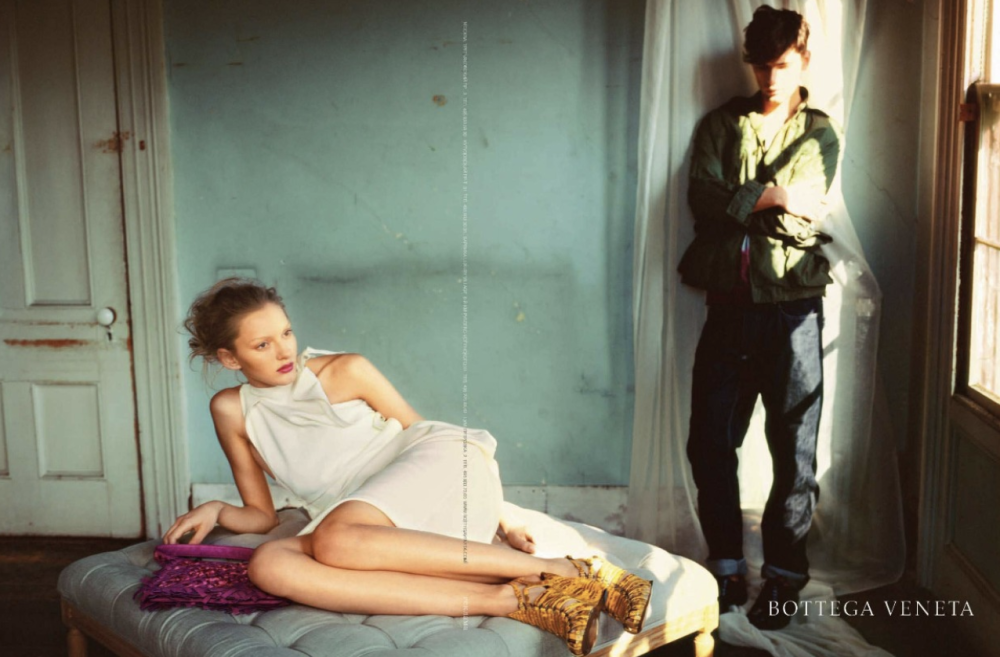
Bottega Veneta, Ad Campaignm S/S 2010
Photographed by Nan Goldin
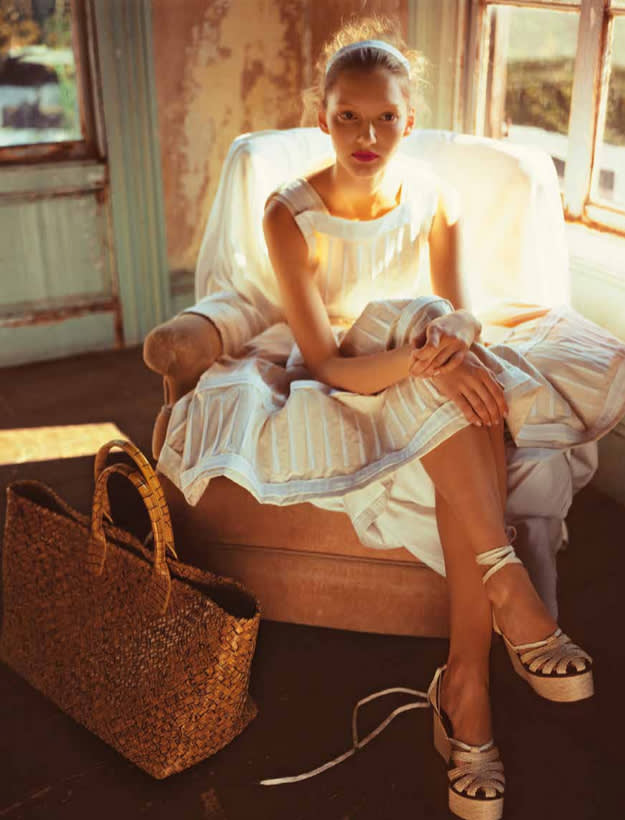
Bottega Veneta, Ad Campaignm S/S 2010
Photographed by Nan Goldin

Bottega Veneta, Ad Campaignm S/S 2010
Photographed by Nan Goldin

Bottega Veneta, Ad Campaign S/S 2011
Photographed by Alex Prager

Bottega Veneta, Ad Campaign S/S 2011
Photographed by Alex Prager

Bottega Veneta, Ad Campaign S/S 2011
Photographed by Alex Prager
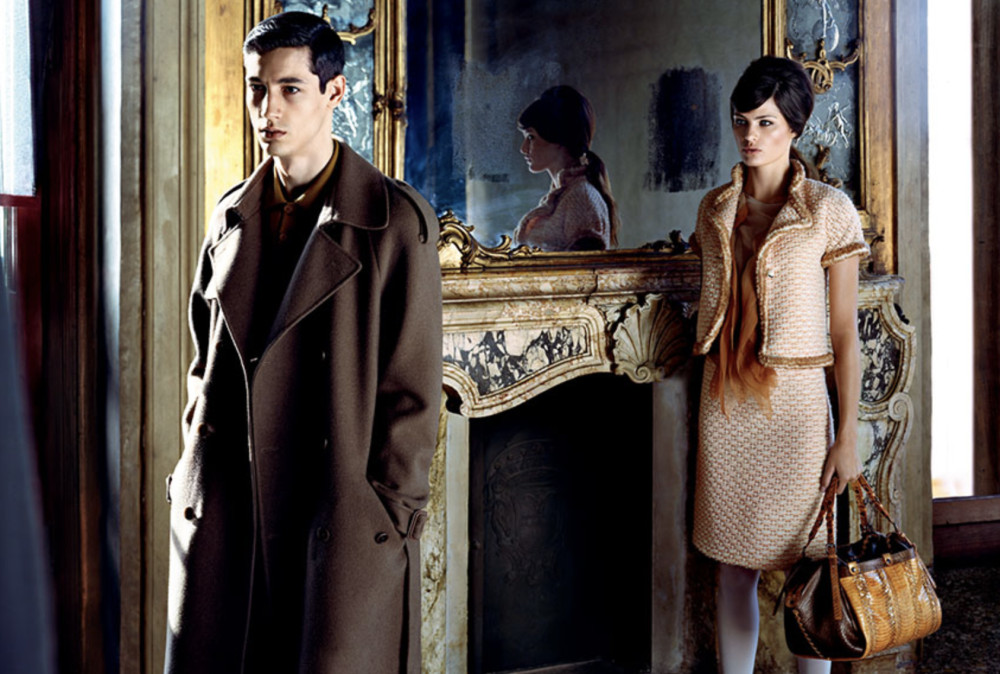
Bottega Veneta, Ad Campaign, F/W 2011
Photographed by Robert Polidori

Bottega Veneta, Ad Campaign, F/W 2011
Photographed by Robert Polidori

Bottega Veneta, Ad Campaign, F/W 2011
Photographed by Robert Polidori

Yohji Yamamoto and Peter Saville
1991

Yohji Yamamoto and Peter Saville
1991

Yohji Yamamoto and Peter Saville
1991

Chloe Ad Campaign, S/S 2001
Photographed by Taryn Simon

Chloe, Ad Campaign, S/S 2001
Photographed by Taryn Simon

Gucci Eyewear, Ad Campaign, 2017
Photographed by Petra Collins
In 1991, Yohji Yammamoto created ads with art director and graphic designer Peter Saville, while in 2001, Chloe worked with multidisciplinary artist Taryn Simon to create powerful photographs featuring horses and models on a beach. Likewise, in 2017 Gucci collaborated with photographer and artist Petra Collins on a campaign for eyewear that affected Collins’ hazy, nostalgic lens.
Many designer/artist collaborations focus on typography, an apt parallel considering how important typeface is to advertisement design. In 2016, Stella McCartney featured the typographic work of American artist Ed Ruscha to spell out phrases like “Veg Out,” “Meat Free” and “No Leathers Feathers or Fur.” Givenchy worked with performance artist marina Abromovic in 2016 to create an installation for the brand’s Spring/Summer show, which included orange-lit letters that read “I Believe in the Power of Love”.

Ed Ruscha for Stella McCartney
Fall/Winter 2016 Ad Campaign

Ed Ruscha for Stella McCartney
Fall/Winter 2016 Ad Campaign

Ed Ruscha for Stella McCartney
Fall/Winter 2016 Ad Campaign

Marina Abromovic for Givenchy
Spring/Summer 2016 Runway Show Installation
Other collaborations use famous works of art as inspiration behind fashion ads. In 2018, Gucci depicted historic paintings like Millais’ “Ophelia” in a cheeky, cartoonish campaign, while Raf Simons created an advertising campaign for Calvin Klein titled “American Classics,” in which works at the Andy Warhol Museum in Pittsburgh were featured in the back of denim and underwear ads. Likewise, in 2012 Louis Vuitton did a series of ads featuring the notorious work of Yayoi Kusama to promote the Japanese designer’s collaboration with the fashion house, while artist Salvador Dali was once even used in a vintage GAP ad promoting Khakis.

The Gap, 'Khakis' Ad Campaign
Featuring a vintage image of Salvador Dalí, 1994
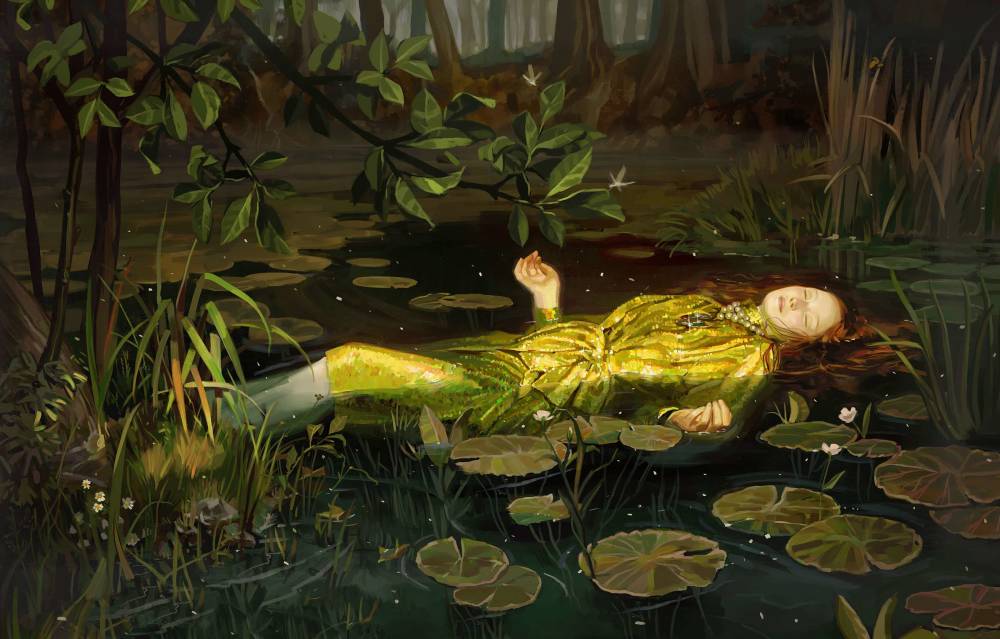
Gucci, Ad Campaign, S/S 2018
Inspired by "Ophelia" by John Everett Millais, 1852

Gucci, Ad Campaign, S/S 2018
Inspired by “The Garden of Earthly Delights” by Hieronymus Bosch, 1490–1510

Calvin Klein, 'American Classics' Ad Campaign, 2018
Raf Simons in Collaboration with The Andy Warhol Foundation

Louis Vuitton
Ad Campaign, featuring Yayoi Kusama, 2012
Artist advertisements are by no means proprietary to the fashion industry. In 1960, for example, Roy Lichtenstein created a New Yorker ad titled “Coffee Break” for a Brazilian coffee brand, featuring two Lichtenstein-style cartoon characters discussing how best to make iced coffee. Salvador Dali did various ads as well, from illustrations for Bryans Hosiery, Elsa Schiaparelli’s Le Roy Soleil perfume and Datsun Automobiles, to a 1969 TV commercial promoting Lanvin chocolate bars and Chupa Chups Lollipops, who used Dali for their logo design.
The New Yorker, Advertisement, 'Coffee break!'
Roy Lichtenstein, 1960
Bryan's Hoisery, Advertisement
Salvador Dalí, 1948
House of Schiaperelli, Advertisement for 'Le Roy Soleil' Fragrance
Salvador Dalí, 1946
Datsun Automobiles, Advertisement
Salvador Dalí, 1973
Vogue Magazine, Cover
Salvador Dalí, 1944
Chupa Chups, Logo Design
Salvador Dalí, 1969
Even before the glossy magazines of today, Pablo Picasso and Jean Cocteau created advertisements for the Ballet Russes in the early twentieth century, featuring their illustrations, while a dove drawing by Picasso went on to become an emblem of the Communist Party in the 1950s, a political advertisement in itself. Cocteau also created ads for Elizabeth Arden Perfume, as well as gorgeous travel posters for Monaco. In 1939, painter Georgia O’Keeffe was commissioned to travel to Hawaii to create paintings for Dole Pineapple Juice. The works, titled Pineapple Bud and Crabs Claw Ginger Hawaii, featured a budding pineapple and a leaf across a background of beach and water.
Pablo Picasso
Ballets Russes, Vintage Advertisement, 1917
Pablo Picasso
The Communist Party, 'Second World Conference of the Defenders of Peace' Poster, 1940s
Jean Cocteau
Elizabeth Arden Perfumes, Advertisement, 1950
Georgia O'Keeffe
Dole Pineapple Juice, Advertisement, 1940
Georgia O'Keeffe
Dole Pineapple Juice, Advertisement, 1940
Finally, Andy Warhol, famed for his mix of high and low art most prominently represented by his work in advertising, has an extensive list of brands and industries to which he has leant his talents. Some of these ads were more personal, while others purely commercial. Posters for his own films — L’Amour, Nude Restaurant, Young Dracula, Trash, Women in Revolt, Chelsea Girls, Lonsesome Cowboys, and Blue Movie — are dwarfed in comparison to the array of commercial ads Warhol created over the years, including those for Macintosh computers, VW Beatle cars, Perrier water, and of course, plenty of work for fashion brands, including Halston, Schiaparelli and Chanel. Warhol’s work balances art with commercial in a way that disrupts and confronts the blueprint of advertisements that the world is most used to.
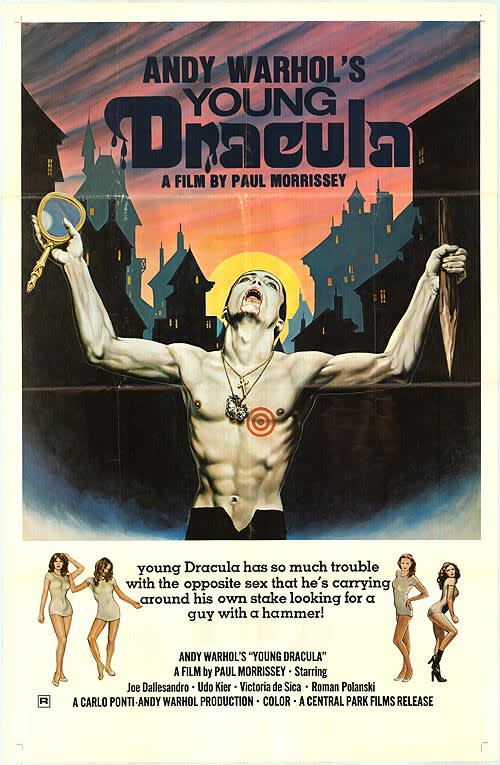
Andy Warhol
Film Poster for Young Dracula

Andy Warhol
Film Poster for Trash

Andy Warhol
Film Poster for Chelsea Girls

Andy Warhol
Film Poster for Lonesome Cowboys

Andy Warhol
Film Poster for Nude Restaurant

House of Schiaparelli, Glove Advertisement
Andy Warhol

Perrier, ‘Perrier Blanc’, Advertisement
Andy Warhol
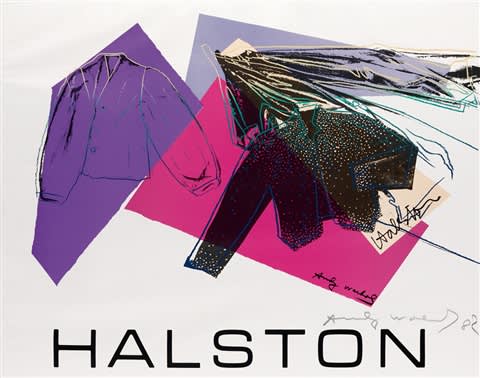
Halston, Advertisement
Andy Warhol

Halston, Advertisement
Andy Warhol
Advertising works on a multitude of levels. Fundamentally, it is trying to sell us something, but that something can be an idea, feeling, or state of mind, as opposed to a product. When artists make ad campaigns, they are often written off as “sell-outs,” but ultimately even the high art world has high levels of commerciality. Instead of rejecting the commercial, many artists have embraced this fact, a tradition we have seen exist dating back to the earliest days of Pablo Picasso.



